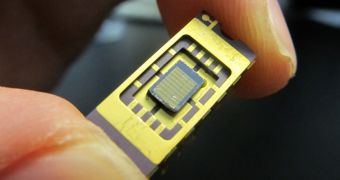Light really has become the foundation for the next breakthroughs in terms of data transmissions, so Stanford University researchers took it upon themselves to develop a new LED-based technology.
Cutting right to the point, computer chips with LED-based optical communications will be about 2,000 times more efficient that those with laser-based optical interconnects.
Or at least, a nanoscale LED setup is 2,000 times more efficient that a laser one, consuming just 0.25 femto-joules per bit sent instead of 500 femto-joules.
“Traditionally, engineers have thought only lasers can communicate at high data rates and ultralow power,” stated Gary Shambat, a doctoral candidate in electrical engineering.
“Our nanophotonic, single-mode LED can perform all the same tasks as lasers, but at much lower power.”
Single-mode LEDs were used in a new design that creates a single frequency of light.
Electricity applied to dots of indium arsenide give off light as current passes through them, light that ends up focused by a photonic crystal.
The photonic crystal, a semiconductor bearing an array of holes, forces the light to resonate at a desired frequency and produces the beam of light by filling the role of a focusing mirror.
“Low-power, electrically controlled light sources are vital for next-generation optical systems to meet the growing energy demands of the computer industry,” said Jelena Vuckovic, an associate professor of electrical engineering,
“This moves us in that direction significantly. […] Our device is some 2,000 times more energy efficient than best devices in use today,” Vuckovic added.
Naturally, regardless of how efficient, the invention wouldn't be relevant if it weren't at least moderately fast.
As it happens, the maximum rate achievable is well beyond moderate, at 10 Gbps (and maybe more as time passes), or so the researchers claim.
Thus, the time it will take for yet lower-power but strong computing products to become reality might turn out to be shorter than expected.

 14 DAY TRIAL //
14 DAY TRIAL //